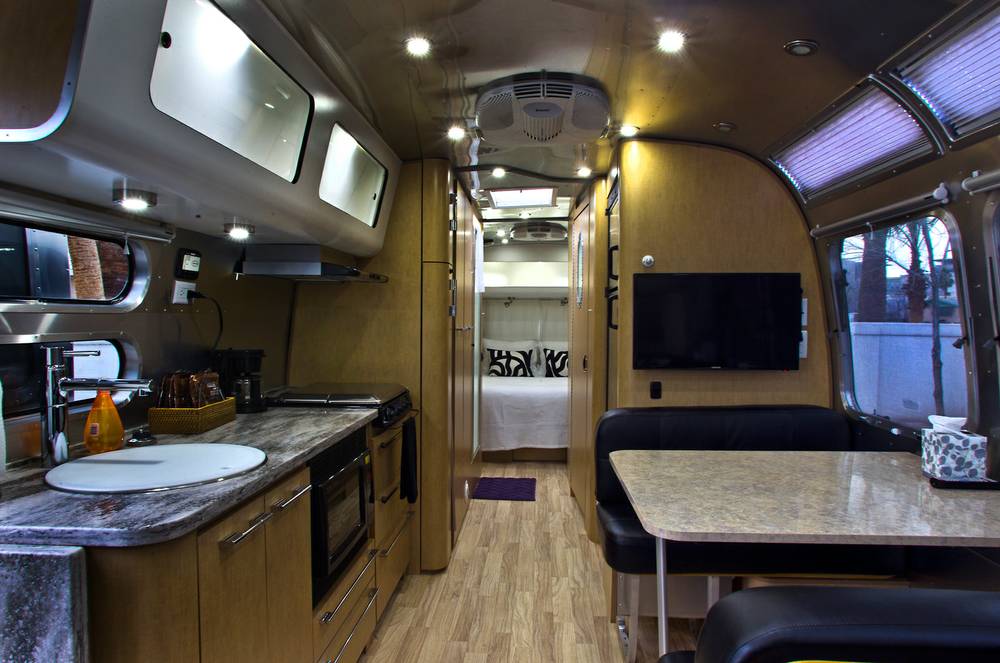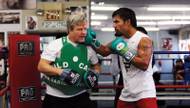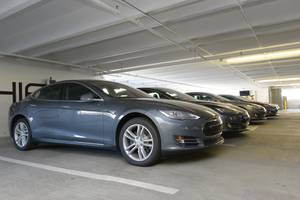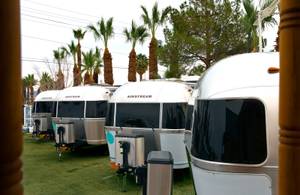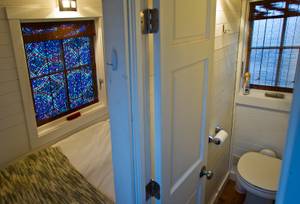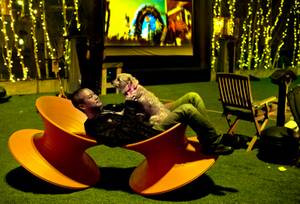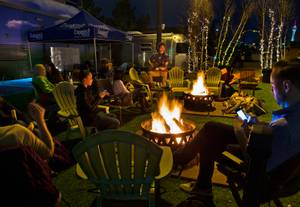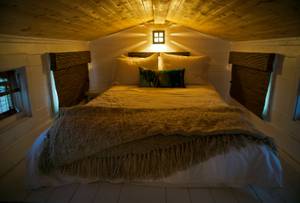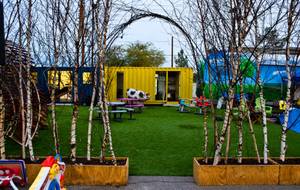You’re standing in a kitchen with Tony Hsieh when you learn something new and surprising about him. You already know he heads up Zappos, which is now owned by Amazon. You know he’s behind Downtown Project, the sometimes controversial investment group responsible for revitalizing the city’s center. You know he’s into Burning Man and brought that fire-breathing mantis to the Container Park.
What you don’t know is that, among his talents, he regards two most highly. You learn this while staying at the Airstream park, the mysterious lot of trailers and tiny cabins next to Atomic Liquors.
“Do you like spicy or kimchi?” he asks, standing in the community kitchen, which is housed in a shipping container.
You ponder. “Both.”
“How spicy on the Le Thai scale of one to five?”
“Medium?”
“I made kimchi noodle egg drop soup,” he says.
The batch is “third-generation,” because it’s been sampled and augmented a few times over. As long as there are noodles, veggies, seasonings and beer, this soup could go on forever.
“I have two skills,” Hsieh declares, testing the broth. “I’m the world’s best iPhone photographer, and I’m the best improv soup maker.”
From there, he suggests an Iron Chef challenge ... maybe with celebrity chefs from Life Is Beautiful ... using leftover inventory from restaurants and grocery stores.
And like that, a concept is born. The spontaneity is not unusual for Hsieh’s ideas; after all, it’s how the Airstream Living Experiment came about.
“It came from a ‘Why the hell not?’” says Janice Lopez, a project manager for Downtown Project who oversees the park’s evolving design.
Flash back to October, Hsieh and Lopez laying out blueprints on the floor of Hsieh’s Ogden apartment. Post-its with names scrawled on them shuffle around the map. Who wants an Airstream? Who wants a Tumbleweed Tiny House? Shared amenities include kitchen, laundry, community pantry, an outdoor living room with fire pits and coworking buses. And then there’s a wish list: pool, dome, tents, solar, a playroom for kids.
Inside, the Airstreams are sleek and high-tech, with wood paneling, stainless-steel appliances, a Bluetooth stereo and two TVs. The Tumbleweeds are homier, with the feel of a modern wood cabin, but with less tech and less space—the main sleeping quarters are lofted, and there’s no couch or kitchen table. The trailers were initially purchased for a hotel concept, but that hasn’t gotten off the ground.
Brad Johnson, a former Downtown Project employee who now manages the Airstream park, worked on that hotel project but says the timing wasn’t right because Container Park had just opened and the Bunkhouse Saloon was still being renovated. The location lacked foot traffic, so the 30 trailers sat unused on an RV lot owned by Downtown Project.
“We had a couple million dollars in trailers sitting in a parking lot,” says Johnson, known at the park as Ranger Brad.
Lopez says inspiration for the Airstream Living Experiment struck during a walk down Fremont. How could they draw people further east, where a bookstore was set to open and a record shop and restaurant were in the works? What if they moved in? Hsieh agreed to try it.
“Four months ago, we were all up there,” Lopez says, pointing to Ogden Apartments from the lot on Fremont and 10th. “Next thing I know I’m giving tours.”
Staying at the Airstream park is part ordinary, part surreal. The ordinary is evident on weekdays, when residents are at work and the park is mostly silent, save for groundskeepers and Blizzy, Hsieh’s rescue terrier, bouncing around the property.
Nights are typically more lively, though not always. Each night there’s a bonfire and a movie, usually an action flick, projected onto a blow-up screen. Sometimes only a few folks gather, other times there are dozens, with guests from all corners of the world. Most of the time, it’s like any other residence, with people coming and going.
But then things like this happen. It’s Saturday morning after a late night of drinking Fernet and chatting up Airstream guests, including a film festival owner and an excitable German gent. Hsieh calls and asks what you’re doing.
“Sleeping.”
“Can you be ready in 10 minutes?”
“Why?”
“It’s a secret.”
Dressed in last night’s clothing you emerge from your trailer to load into—what else?—a rock star tour bus that was used for Hsieh’s Delivering Happiness book tour.
Carrying five humans and two furry friends, the bus heads south, exits near the airport and turns right. There’s some confusion initially, but after directions are solicited from strangers, you arrive at a nondescript warehouse complex. Outside an open garage there’s a large piece of Star Wars-looking metal, folded upon itself. It seems to have eyes, and a tail ... and teeth?
“That’s Robosaurus,” Hsieh says before climbing into the creature’s skull, where the control panels are housed. “Are you glad you came?”
The spiky-haired, black-clad crew gives a demo of the dino in full glory, lurching and spewing fire and swinging its tail. It crushes cars in its jaws and has been featured on TV and in monster-truck events. Hsieh is checking it out up close, wondering aloud if there’s a way to incorporate it into Downtown.
There could be. There probably is.
“It’s constant experimentation with new ideas,” Hsieh says of the Airstream park, though he could be talking about Downtown as a whole.
He says he prefers Airstream living to his Ogden apartment, that he considers his trailer a bedroom and the fire pit area a living room. Shared common areas encourage “collisions,” or chance meetings, of which Hsieh is known to be fond. He says the park was inspired by Burning Man for its communal nature and randomness.
“We want people to contribute more than they take,” he says. “For some people, it might be cooking for everyone. For others it might be playing music.”
Music is the gift of choice from Daniel Park, a regular at the Airstream Living Experiment. As resident musician, Park finds himself singing around the campfire a few times a week.
Hsieh gives Park’s move-in as an example of the experiment’s unplanned nature. Initially, the two met there for a meeting. “We randomly invited Daniel to Airstream park,” Hsieh says. “He stayed and played music till 5, so he crashed here.”
Park says he was originally supposed to meet Hsieh at Container Park, where he will play the first and third Fridays in February, but the meeting moved to Airstream. When he arrived, “people were making hot dogs and hamburgers,” Park recalls. “They handed me a shot and a beer and said, ‘Check this out.’” A few sing-along songs turned into an all-nighter, and Park has more or less lived there since. Collaborations, like the time he jammed with a member of Santana, are a perk, too.
For Park, living small isn’t an issue. “It was an easy transition,” he says. “I used to travel as a musician so I’ve lived out of a duffel.”
The tiny spaces (about 200 square feet in an Airstream and about 130 in a Tumbleweed) are easy to clean and keep him from acquiring too much. “It’s definitely a unique experience. It allows me to be more creative, in a way, because it helps me concentrate on what’s important.”
Small-space living, defined as under 200 square feet, has gained popularity in recent years for its environmental- and wallet-friendliness. In Graham Hill’s 2011 TED Talk “Less stuff, more happiness” the treehugger.com founder extols three tenets: edit ruthlessly, think small and create multifunctional spaces. “Less stuff and less space are going to equal a smaller footprint—this is actually a great way to save you some money—and a little more ease in your life,” says Hill, referring to his 420-square-foot Manhattan apartment, which is tricked out with a moving wall and dual-use designs to increase space efficiency.
The concept resonated with Hsieh. “For me, experiences are more meaningful than stuff,” he says. “I have way more experiences here at Airstream.”
In the 2012 documentary, We the Tiny House People, Hill further explains his preference for small living. “I believe that the skill of the century is editing,” Hill tells host SuChin Pak. “Cutting back on space, cutting back on possessions, cutting back on media, cutting back on friends. I think you’ve got to refine, because it gives you lots of mental clarity, and a lot more space, and a lot more flexibility. And it’s also really good financially.”
The financial and mental freedom resonate for others in 2013’s Tiny: A Story About Living Small, which follows a couple as they build a tiny home from scratch, and interviews others who have downsized their lives, often parking their trailers in friends’ backyards. “The primary asset that comes with a small house is freedom,” Jay Schaefer, founder of Tumbleweed Tiny House Co., says in the film. “The world gets a lot bigger when you’re living small. I can afford to do a lot more things now in terms of cash and time. The whole world is now my living room.”
Lopez has a loft at Juhl but often stays overnight at the park with her son and daughter, who prefer it to their condo. She admits that she sometimes wonders whether she’s making the right choice for her children, but when she takes them home each week, “by night they’re begging me to come back here.”
At the park they have toys, outdoor movies, lots of room to play and a bus that’s being converted into a playroom. The entrepreneurial minds that pass through are a perk, too. Lopez’s daughter started a s’mores shop, then expanded to savory snacks and upgraded her storefront at the suggestion of visitors. “Where else can you expose your kids to such a flexible space and teach them another way of living?” Lopez asks.
Sure, it’s not the norm, but “Life will give them every opportunity to learn all things conventional,” she says. “That’s what Downtown revitalization is about. It’s about doing things differently.”
Still, those who participate in the experiment realize it’s a unique way of life. “You’re pretty much forced to say hello,” Park says of communal living. “It’s not necessarily a bad thing, but it might not be for everyone.”
Something else that might not be for everyone: showering in an Airstream.
It’s a tight fit for an average woman, let alone a tall woman, or a man. Kids might do all right. And although the spaces are high-tech and functional, it’s a little awkward getting dressed in the morning (Do you stand in the living room? What if you have company?) or storing more than a suitcase of clothing.
But that’s all part of the experiment. The hotel concept isn’t off the table, and neither is anything else the team might dream up during its stay. (A bus-maze entrance, however, was nixed by the city for fire-safety reasons.)
“The whole point is that there’s no master plan,” Hsieh says. “When we first moved in here it wasn’t ‘Let’s see what works for a hotel.’ It was just ‘Let’s see what happens.’”
One plan calls for the Life Is Beautiful Festival to use the park for an artist-in-residence program. And who knows, the Airstream Iron Chef challenge could actually happen. That’s the beauty of living here, Park says. You meet people, you do things, “and sometimes you make soup with random strangers.”
